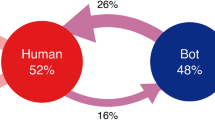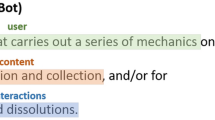Abstract
The 2022 Russian invasion of Ukraine emphasises the role social media plays in modern-day warfare, with conflict occurring in both the physical and information environments. There is a large body of work on identifying malicious cyber-activity, but less focusing on the effect this activity has on the overall conversation, especially with regards to the Russia/Ukraine Conflict. Here, we employ a variety of techniques including information theoretic measures, sentiment and linguistic analysis, and time series techniques to understand how bot activity influences wider online discourse. By aggregating account groups we find significant information flows from bot-like accounts to non-bot accounts with behaviour differing between sides. Pro-Russian non-bot accounts are most influential overall, with information flows to a variety of other account groups. No significant outward flows exist from pro-Ukrainian non-bot accounts, with significant flows from pro-Ukrainian bot accounts into pro-Ukrainian non-bot accounts. We find that bot activity drives an increase in conversations surrounding angst (with \(p = 2.450 \times 10^{-4}\) ) as well as those surrounding work/governance (with \(p = 3.803 \times 10^{-18}\) ). Bot activity also shows a significant relationship with non-bot sentiment (with \(p = 3.760 \times 10^{-4}\) ), where we find the relationship holds in both directions. This work extends and combines existing techniques to quantify how bots are influencing people in the online conversation around the Russia/Ukraine invasion. It opens up avenues for researchers to understand quantitatively how these malicious campaigns operate, and what makes them impactful.
Access this chapter
Tax calculation will be finalised at checkout
Purchases are for personal use only
Similar content being viewed by others
References
Bagrow, J.P., Liu, X., Mitchell, L.: Information flow reveals prediction limits in online social activity. Nat. Hum. Behav. 3(2), 122–128 (2019). https://doi.org/10.1038/s41562-018-0510-5
Bagrow, J.P., Mitchell, L.: The quoter model: a paradigmatic model of the social flow of written information. Chaos Interdisc. J. Nonlinear Sci. 28(7), 075304 (2018)
Barabási, A.L.: Network Science. Cambridge University Press, Cambridge (2016)
Caldarelli, G.: Scale-Free Networks: Complex Webs in Nature and Technology. Oxford University Press, Oxford (2007)
Champion, M., Krasnolutska, D.: Ukraine’s TV comedian President Volodymyr Zelenskyy finds his role as wartime leader, February 2022. https://www.japantimes.co.jp/news/2022/02/26/world/volodymyr-zelenskyy-wartime-president/
Chen, E., Ferrara, E.: Tweets in time of conflict: a public dataset tracking the twitter discourse on the war between Ukraine and Russia. arXiv preprint arXiv:2203.07488 (2022)
Collins, B.: After Mueller report, Twitter bots pushed ‘Russiagate hoax’ narrative (2019). https://www.nbcnews.com/tech/tech-news/after-mueller-report-twitter-bots-pushed-russiagate-hoax-narrative-n997441. Accessed 19 June 2022
Collins, B., Korecki, N.: Twitter bans over 100 accounts that pushed #IStandWithPutin, March 2022. https://www.nbcnews.com/tech/internet/twitter-bans-100-accounts-pushed-istandwithputin-rcna18655
Cresci, S., Di Pietro, R., Petrocchi, M., Spognardi, A., Tesconi, M.: The paradigm-shift of social spambots: evidence, theories, and tools for the arms race. In: Proceedings of the 26th International Conference on World Wide Web Companion, WWW 2017, pp. 963–972, Companion, International World Wide Web Conferences Steering Committee, Republic and Canton of Geneva, CHE, April 2017. https://doi.org/10.1145/3041021.3055135
Doroshenko, L., Lukito, J.: Trollfare: Russia’s disinformation campaign during military conflict in Ukraine. Int. J. Commun. 15, 4662–4689 (2021)
Druziuk, Y.: A citizen-like chatbot allows Ukrainians to report to the government when they spot Russian troops - here’s how it works. Business Insider, April 2022. https://www.businessinsider.com/ukraine-military-e-enemy-telegram-app-2022-4. Accessed 19 June 2022
Giglietto, F., Righetti, N., Rossi, L., Marino, G.: It takes a village to manipulate the media: coordinated link sharing behavior during 2018 and 2019 Italian elections. Inf. Commun. Soc. 23(6), 867–891 (2020). https://doi.org/10.1080/1369118X.2020.1739732
Hutto, C., Gilbert, E.: Vader: a parsimonious rule-based model for sentiment analysis of social media text. In: Proceedings of the International AAAI Conference on Web and Social Media, vol. 8, pp. 216–225 (2014)
Keller, F.B., Schoch, D., Stier, S., Yang, J.: Political astroturfing on twitter: how to coordinate a disinformation campaign. Polit. Commun. 37(2), 256–280 (2020)
Keller, T.R., Klinger, U.: Social bots in election campaigns: theoretical, empirical, and methodological implications. Polit. Commun. 36(1), 171–189 (2019). https://doi.org/10.1080/10584609.2018.1526238
Klepper, D.: Russian propaganda ‘outgunned’ by social media rebuttals. AP NEWS, March 2022. https://tinyurl.com/3x9anuta. Section: Russia-Ukraine war
Kontoyiannis, I., Algoet, P.H., Suhov, Y.M., Wyner, A.J.: Nonparametric entropy estimation for stationary processes and random fields, with applications to English text. IEEE Trans. Inf. Theory 44(3), 1319–1327 (1998)
Laurence, P.: How Ukraine’s ‘Ghost of Kyiv’ legendary pilot was born. BBC News, May 2022. https://www.bbc.com/news/world-europe-61285833. Accessed 19 June 2022
Lukito, J.: Coordinating a multi-platform disinformation campaign: internet research agency activity on three us social media platforms, 2015 to 2017. Polit. Commun. 37(2), 238–255 (2020). https://doi.org/10.1080/10584609.2019.1661889
Mathews, P., Mitchell, L., Nguyen, G., Bean, N.: The nature and origin of heavy tails in retweet activity. In: Proceedings of the 26th International Conference on World Wide Web Companion, pp. 1493–1498 (2017)
Matthews, B.: Best time to tweet for clicks, retweets and engagement. Empower Agency, June 2015. https://empower.agency/best-time-to-tweet-clicks-retweets-engagement/. Accessed 19 June 2022
Muscat, S., Siebert, Z.: Laptop generals and bot armies: the digital front of Russia’s Ukraine war, March 2022. https://eu.boell.org/en/2022/03/01/laptop-generals-and-bot-armies-digital-front-russias-ukraine-war. Accessed 19 June 2022
Newman, M.: Networks. Oxford University Press, Oxford (2018)
Nguyen, K.: How Putin’s propaganda is sowing seeds of doubt to deny sympathy for Ukraine. ABC News, April 2022
Orabi, M., Mouheb, D., Al Aghbari, Z., Kamel, I.: Detection of bots in social media: a systematic review. Inf. Process. Manag. 57(4), 102250 (2020). https://doi.org/10.1016/j.ipm.2020.102250
Osborne, C.: Ukraine destroys five bot farms that were spreading ‘panic’ among citizens, March 2022. https://www.zdnet.com/article/ukraine-takes-out-five-bot-farms-spreading-panic-among-citizens/
Pacheco, D., Hui, P.M., Torres-Lugo, C., Truong, B.T., Flammini, A., Menczer, F.: Uncovering coordinated networks on social media: methods and case studies. In: Proceedings of the AAAI International Conference on Web and Social Media (ICWSM), pp. 455–466 (2021)
Pennebaker, J.W., Francis, M.E.: Cognitive, emotional, and language processes in disclosure. Cogn. Emot. 10(6), 601–626 (1996). https://doi.org/10.1080/026999396380079
Pennebaker, J.W., Francis, M.E., Booth, R.J.: Linguistic inquiry and word count: LIWC 2001, vol. 71. Lawrence Erlbaum Associates, Mahway (2001)
Polyzos, E.S.: Escalating tension and the war in Ukraine: evidence using impulse response functions on economic indicators and twitter sentiment. Available at SSRN 4058364 (2022)
Pond, T., Magsarjav, S., South, T., Mitchell, L., Bagrow, J.P.: Complex contagion features without social reinforcement in a model of social information flow. Entropy 22(3), 265 (2020). https://doi.org/10.3390/e22030265
Purtill, J.: When it comes to spreading disinformation online, Russia has a massive bot army on its side. ABC News, March 2022
Sayyadiharikandeh, M., Varol, O., Yang, K.C., Flammini, A., Menczer, F.: Detection of novel social bots by ensembles of specialized classifiers. In: Proceedings of the 29th ACM International Conference on Information and Knowledge Management, pp. 2725–2732, October 2020. https://doi.org/10.1145/3340531.3412698
Schoch, D., Keller, F.B., Stier, S., Yang, J.: Coordination patterns reveal online political astroturfing across the world. Sci. Rep. 12(1), 4572 (2022). https://doi.org/10.1038/s41598-022-08404-9
Shane, S.: The fake Americans Russia created to influence the election. The New York Times, September 2017. https://www.nytimes.com/2017/09/07/us/politics/russia-facebook-twitter-election.html. Accessed 19 June 2022
South, T., Smart, B., Roughan, M., Mitchell, L.: Information flow estimation: a study of news on Twitter. Online Soc. Netw. Media 31, 100231 (2022). https://doi.org/10.1016/j.osnem.2022.100231. https://www.sciencedirect.com/science/article/pii/S2468696422000337. ISSN: 2468–6964
Stella, M., Ferrara, E., Domenico, M.D.: Bots increase exposure to negative and inflammatory content in online social systems. Proc. Natl. Acad. Sci. 115(49), 12435–12440 (2018). https://doi.org/10.1073/pnas.1803470115. https://www.pnas.org/doi/abs/10.1073/pnas.1803470115
Thomas, T.: Russia’s reflexive control theory and the military. J. Slav. Mil. Stud. 17(2), 237–256 (2004). https://doi.org/10.1080/13518040490450529
Watt, J., Smart, B.: Tweets discussing the Russia/Ukraine War, August 2022. https://doi.org/10.6084/m9.figshare.20486910.v4. https://figshare.com/articles/dataset/Tweet_IDs_Botometer_results/20486910
Wong, E.: U.S. fights bioweapons disinformation pushed by Russia and China. The New York Times, March 2022. https://www.nytimes.com/2022/03/10/us/politics/russia-ukraine-china-bioweapons.html. Accessed 19 June 2022
Yang, K.C., Ferrara, E., Menczer, F.: Botometer 101: social bot practicum for computational social scientists, January 2022. https://doi.org/10.48550/arXiv.2201.01608
Acknowledgements
B.S. would like to acknowledge the support of a Westpac Future Leaders Scholarship. L.M. and M.R. are supported by the Australian Government through the Australian Research Council’s Discovery Projects funding scheme (project DP210103700). L.M. also acknowledges support from the Australian Defence Science and Technology Group ORNet scheme.
Author information
Authors and Affiliations
Corresponding author
Editor information
Editors and Affiliations
Rights and permissions
Copyright information
© 2022 The Author(s), under exclusive license to Springer Nature Switzerland AG
About this paper
Cite this paper
Smart, B., Watt, J., Benedetti, S., Mitchell, L., Roughan, M. (2022). #IStandWithPutin Versus #IStandWithUkraine: The Interaction of Bots and Humans in Discussion of the Russia/Ukraine War. In: Hopfgartner, F., Jaidka, K., Mayr, P., Jose, J., Breitsohl, J. (eds) Social Informatics. SocInfo 2022. Lecture Notes in Computer Science, vol 13618. Springer, Cham. https://doi.org/10.1007/978-3-031-19097-1_3
Download citation
DOI: https://doi.org/10.1007/978-3-031-19097-1_3
Published:
Publisher Name: Springer, Cham
Print ISBN: 978-3-031-19096-4
Online ISBN: 978-3-031-19097-1
eBook Packages: Computer ScienceComputer Science (R0)




